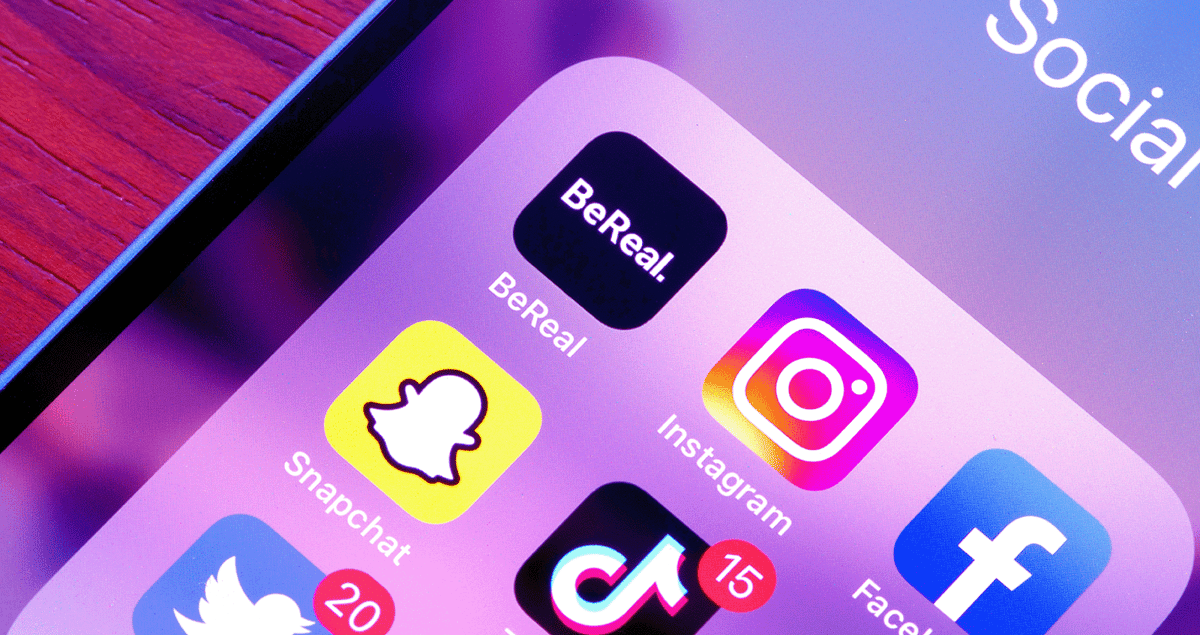
Social media companies have forged the next frontier of the marketing industry, with the number of social media users in the U.S. expected to surpass 340 million by 2029. Marketers now have instant access to large concentrations of consumers, needing only a few clicks to target wide audiences with marketing campaigns. And big names like TikTok and Instagram are just a few of the platforms marketers can explore to maximize their audience reach.
Top Social Media Companies
- YouTube
- TikTok
- X
There’s a wide range of social media companies to choose from, and each platform has its own niche and focus — from Nextdoor that seeks to build strong community bonds among neighbors to Quora that wants users to lend a hand by answering others’ questions. Marketers, as a result, will need to spend some time identifying the right platform for their brands.
Below is a list of some of the most popular social media companies marketing teams need to know about to inform their digital marketing strategies.
Social Media Companies to Know
Founded: 2004
Meta operates social media behemoth Facebook, which has a worldwide reach with over three billion people using the platform monthly. Facebook also has a wide array of groups based on topics or interests that marketers can target. The social media platform not only allows users to share their activities, comments, photos and videos, but also create sub-groups for just family members, or people who have a similar topic interest.
How marketers can use it: Facebook offers marketers brand templates and a slate of free tools, which include action buttons that encourage users to shop, send a message or book an appointment. These buttons are positioned at the top of your organization’s Facebook page, so customers view them first. Facebook also offers an e-commerce area on Facebook Marketplace.
Founded: 2005
Social media titan YouTube is a video platform that features user-uploaded videos on a range of topics from sports to music. In 2020, the platform launched YouTube Shorts, giving users an opportunity to create short-form videos, similar to those on TikTok, a major competitor.
How marketers can use it: Marketers can build their brand on this popular video platform if done right. One best practice, according to YouTube, is to use various video formats to grab users’ attention. You can also use Google’s Find My Audience tool to help identify the right audience for your video or ads.
Founded: 2009
Phone, chat and video call giant WhatsApp is a global communications tool that offers several ways for marketers to build their brands. One is using the WhatsApp Groups feature to connect with users interested in anything from sports to entertainment to technology.
How marketers can use it: By finding groups relevant to businesses, WhatsApp could provide rich ground for marketers to gather informal market research and conduct focus groups before launching a new product or service. Teams can also tap into their WhatsApp group to inform members of special promotions and offers. Or, marketers can update their company’s status with WhatsApp Stories, which is similar to Instagram Stories.
Founded: 2010
Instagram is an ideal platform for marketers to tell their brand’s story, since its visual content is centered on storytelling. Instagram lets users post photos, videos and comments, view random videos others have posted, and shop right from their feeds. Roughly one-third of the social media platform’s users are 18 to 24 years old.
How marketers can use it: Instagram offers marketers storytelling tools like Reels (which allows you to edit short videos and share them), Threads (where you can share and comment on conversations) and Stories (where you can post photos and videos). Marketers can use these tools to bring more attention to their products or services, which can also be sold on Instagram Shopping.
Founded: 2016
On TikTok, users can post a range of short video content, from 15-second clips of skits or food reviews to a 10-minute video of a bedroom redesign. TikTok lets users film, edit and add audio to videos all within its app, which can then be posted and engaged with through likes, comments and shares.
How marketers can use it: Marketers can use the platform to offer contests and challenges to build their brand, as well as create specific content — like trends, memes or informational videos — for TikTok’s audience. Brands can also sponsor TikTok creators to spotlight their products or services to a wider audience. Additionally, TikTok Shop, an e-commerce component of TikTok, allows brands and creators to sell their products directly to users on the platform.
Founded: 2011
Owned by Chinese tech company Tencent, WeChat is a social messaging app that offers text chat, voice, video and mobile payments. Marketers can leverage WeChat to offer loyalty programs that deliver location-based promotions with its geo-location technology.
How marketers can use it: Although users in the United States don’t have access to its group chat feature, U.S. companies can use its WeChat Mini Programs to sell products after they secure a foreign business license. Mini Programs can also be used to create experiences. For instance, WeChat partnered with 11 museums to create a “Museum in the Cloud” experience, which allowed art lovers a way to virtually visit the museums.
Founded: 2003
LinkedIn is a social networking site for business professionals, where users can post their resumes along with articles, photos and videos. For marketers, using LinkedIn can give access to C-suite executives and other decision-makers.
How marketers can use it: The social media site offers tools specifically for marketers as part of its marketing and advertising service, LinkedIn Marketing. After creating a LinkedIn page for your organization to share company news and updates, you can also add LinkedIn advertisements to tout your business and tie them back to your LinkedIn page.
Founded: 2006
X, formerly Twitter, is one of the early pioneers in social media. It is especially popular with users between the ages of 25 to 34 years old, who account for 38.5 percent of the total user base. X acts as a microblogging site where users send out tweets to their followers that can contain comments, photos and videos. Users can also repost or redirect posts on their feed from others to their own followers.
How marketers can use it: For marketers, X can be used to post quick updates and announcements about a product or service, or for gathering market information about your followers. When preparing an X post, for example, you have the option of adding a poll. Through these informal polls, you may learn more about your followers, which in turn may help target the next steps to expand your brand. X also features Communities, discussion groups centered around specific topics where users can have conversations and share ideas with one another.
Founded: 2005
Reddit operates as a network for users to discover online communities based on topics and shared interests. Reddit members post comments, links, photos and videos on the site, which has a wide array of interest-based communities, or subreddits. Users can then vote on these posts, with those receiving the most upvotes rising toward the top of the category page.
How marketers can use it: Reddit can equip marketers with valuable intelligence on what consumers think about their brand, products, competitors or industry since 90 percent of its users trust the site to learn about new products and brands. Most subreddits have explicit rules that ban posting an ad to their community or engaging in blatant self-promotion, so it may be best to use this site for market research and engaging with Reddit users.
Founded: 2009
Pinterest attracts users who are looking for ideas on a variety of projects as they scan through a large depository of photos and videos others have uploaded. Marketers can get in front of these users and build brand awareness on Pinterest by showcasing their products in unique and artful ways.
How marketers can use it: The site also offers business accounts and advice on how to market your goods, such as offering five formats to display photos and video (like carousels of rotating images or collections that group several photos together). Your company can also connect its Shopify or WooCommerce stores to a Pinterest business account to conduct e-commerce transactions.
Founded: 2009
Quora is a social media platform that allows users to post questions and respond to others. One way you can use the site is by creating a business account, which can display your company’s name and logo, and searching the site using keywords like your company’s name, your competitor’s name or name of the product or service category you are in.
How marketers can use it: Have one of your company experts answer questions to start building brand authority and awareness. Quora notes on its site that higher-quality responses — those that demonstrate domain expertise and a unique view — tend to get more engagement and distribution among its members.
Founded: 2007
Twitch is a live streaming platform where users can share their screen with other users, allowing them to watch and participate. It popularly consists of streams for gaming, podcasts, music and art. The largest group of active Twitch users consist of 25 to 34 year olds.
How marketers can use it: Since Twitch is composed of a number of creators, who range from game developers to musicians, one of the ways marketers can expand their brand is to become creators themselves on the site. A mobile game company, for example, could have a game developer provide a tutorial on its channel.
Founded: 2015
Discord is a platform where users can create or join online communities to talk with others. These communities, known as Discord servers, can be used to keep in touch with friends, collaborate professionally or explore and engage in discussions about interests. Discord provides text, voice and video functionalities to help users connect across millions of servers.
How marketers can use it: Brands looking to engage their userbase in real time may utilize Discord as a conversational hub. Creating a company Discord server can encourage continued discussion and a sense of community for users of a product or service. Additionally, brands can make server channels that showcase brand announcements, helpful information or answers to user questions.
Founded: 2007
Highly customizable, Tumblr is a microblogging site that allows users to post short snippets of text, photos, videos, GIFs and music on their private or public feeds.
How marketers can use it: Marketers can customize their Tumblr profile theme, colors, font and layout, which offers more freedom than what other platforms offer. With Tumblr, marketers can also attach the company’s icon to photos that they post on the platform. And with photos and GIFs, both can catch users’ eyes more readily than text.
Founded: 2004
Yelp is a social media site and app where people can rate and post reviews after visiting a location or using a service or product. The reviewers, known as Yelpers, are not paid and Yelp does not have control over what they write.
How marketers can use it: Businesses can boost brand awareness by partnering with the social media site to host a Yelp event and invite Yelp reviewers. Although there is no guarantee the free food, drinks, entertainment or lodging will result in favorable reviews, the potential is there to increase your rating and number of reviews.
Founded: 2011
Nextdoor is a hyperlocal social media site where neighbors and local businesses can share information that pertains to their community. As a result, marketers have the ability to target specific geographic communities, a useful tool when opening a new store location or wanting to promote an event in a specific town.
How marketers can use it: The social media site also has programs specifically designed to help marketers and advertisers reach residents based on their interests and location. Nextdoor has also partnered with companies on various campaigns, like teaming up with Verizon for The Big Neighborhood Meetup program to encourage people in their communities to share a meal and conversation.
Founded: 2020
BeReal lets users catch up with friends, family and others via photos. It sends out a random, daily notification to a user, who has up to two minutes to snap a photo and share it with their BeReal network. Users are encouraged to use raw footage, since the app does not have filters or editing tools people can use before uploading their images.
How marketers can use it: BeReal prohibits the use of the app for advertising, but there are some workarounds for marketers. If your brand can pull off photos without the need for heavy editing, glitzy embellishments or the like, then BeReal may work for you. Mexican restaurant chain Chipotle, for example, posted a photo of its takeout bag with instructions scrawled on how to claim a free entree with its promotion code — keeping to the simple, unadulterated look that has made the app so popular.
Founded: 2009
Grindr operates a dating and social networking app specifically designed to facilitate connections among gay, bisexual, transgender and queer people. Users can send messages, photos and videos as they interact with other users in their local area or take advantage of Grindr’s global capabilities to explore profiles in other geographic locations.
How marketers can use it: Grindr allows marketers to build and launch ad campaigns that engage the app’s millions of users. Marketers who opt to use Grindr’s self-service platform can upload a pre-built advertisement or quickly generate a custom ad. They also benefit from tools for precise scheduling, accessing performance insights and setting ad spending limits. Marketers can contact Grindr to establish a relationship with an account manager for more personalized service.
Founded: 2016
Mastodon is a decentralized open-source social media network where users can create their own social media feeds on servers they operate, rather than adhering to a company’s particular template. As a result, you can create your own rules and regulations for your Mastodon feed.
How marketers can use it: Although you may run your own marketing and advertisements on your feed, Mastodon itself will not use algorithms or push out advertisements to other users’ servers. So, you will want to establish a strong direct following if you want to make a splash. Increasingly viewed as an alternative to X, Mastodon also supports audio, video, pictures, accessibility descriptions, animated avatars, polls and custom emojis.
Founded: 2019
Having started as a project at X, Bluesky is a decentralized platform and is the creation of former X CEO Jack Dorsey. Content is broken up into different feeds to let users view posts from who they follow or discover global posts. Similar to X, users can craft text posts and engage with posts through liking and reposting.
How marketers can use it: Since Bluesky is still growing, marketers have a better chance of producing posts that generate the engagement needed to show up in other users’ feeds. A ‘discover’ tab also gives users suggestions on who to follow. If marketing teams develop enough credibility and popularity on the site, their companies may be recommended to users interested in certain topics and industries.
Founded: 2003
Second Life is a virtual community where users and companies can create their own space, and even buy virtual land or islands that are inhabited by users’ avatars. The site has been around for two decades, long before Facebook changed its name to Meta and the popularity of the metaverse soared.
How marketers can use it: Companies can sell merchandise at the Second Life Marketplace, hold events to demo new products, host conferences, fireside chats and other activities on their island or space, which can mimic those typically found in the real world. Cisco, Dell, Xerox, Intel, and BT are among companies that have held virtual meetings in Second Life, and Accenture even went as far as host virtual recruiting events on the social media platform.
What social media site has the most users?
Facebook has the most users of any social media site, with over three billion monthly active users.
What are the top five social media platforms in the U.S.?
The top five social media platforms most used in the U.S. include:
- YouTube
- TikTok
What is the most profitable social media platform?
What is the fastest growing social media platform?
This post was originally published on this site be sure to check out more of their content








